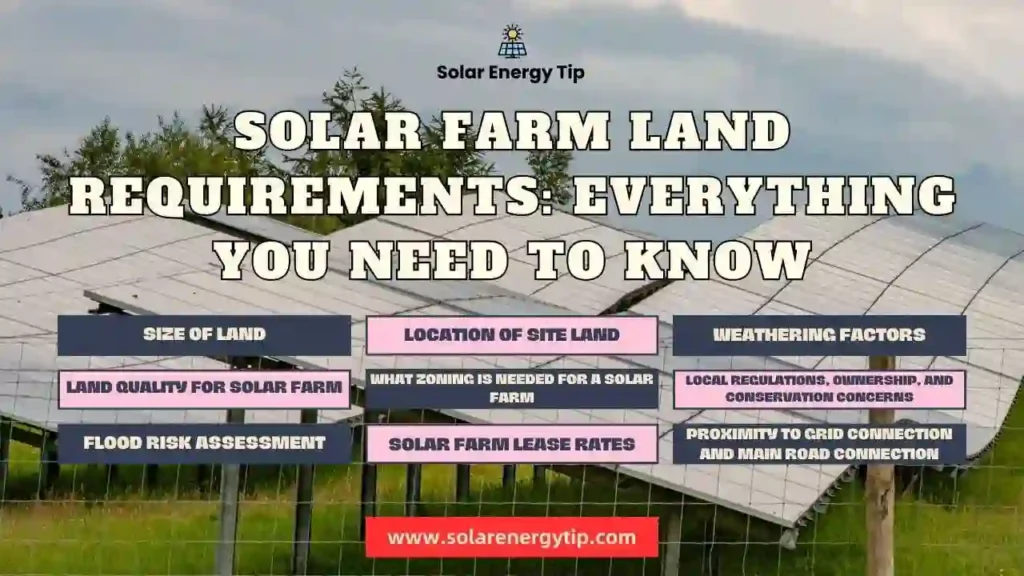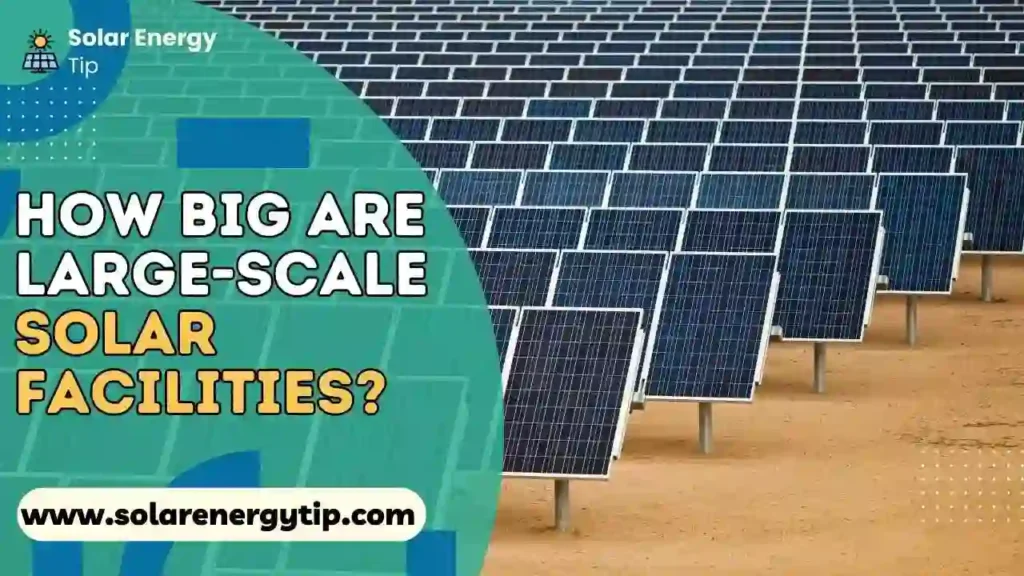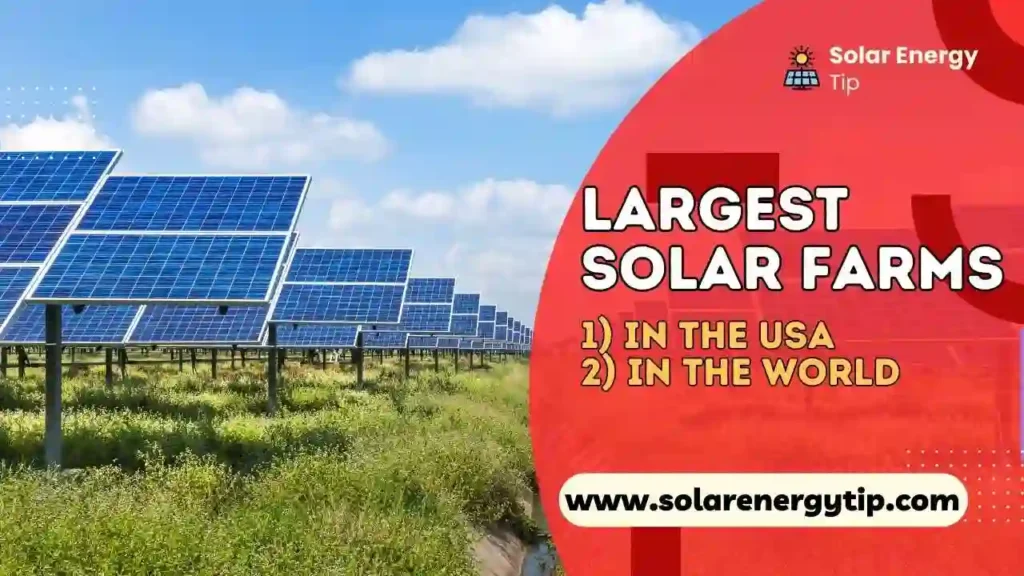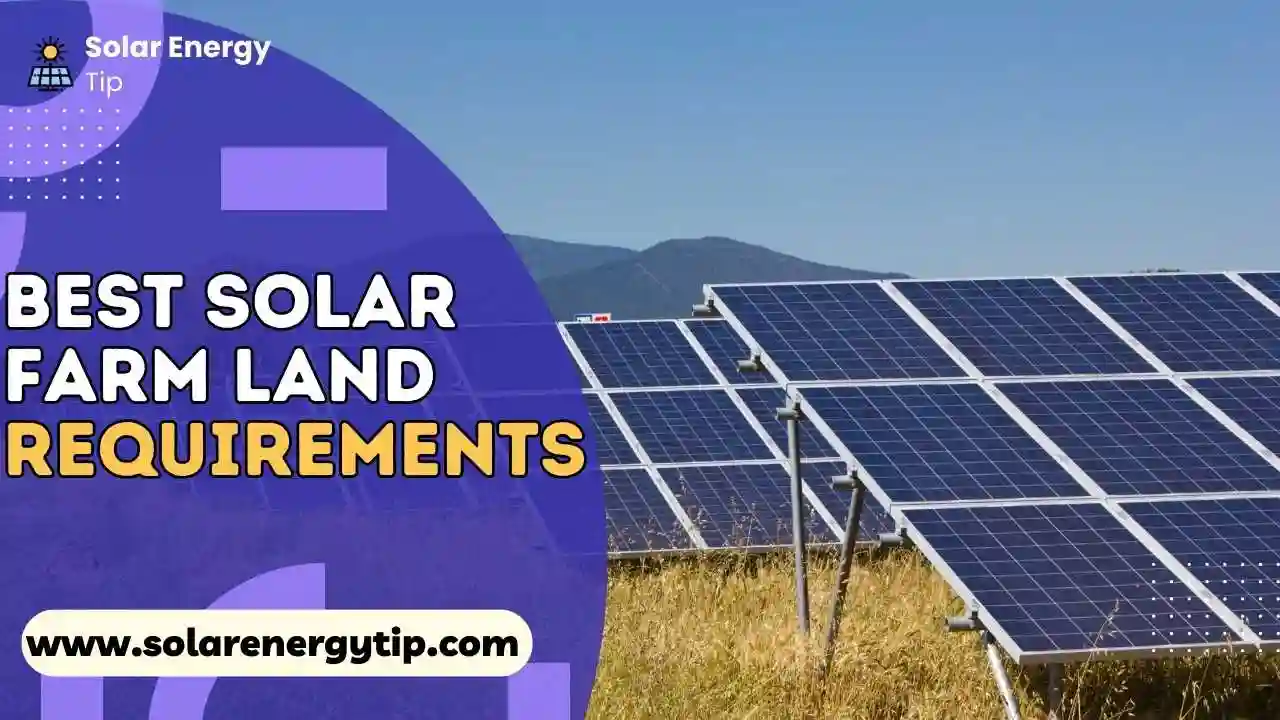Many landowners are considering using their property for solar projects, but the critical question that comes to their mind is Solar farm land requirements.
The number of solar farms established throughout the US has been growing.
The National Renewable Energy Laboratory found that 0.6 percent of the nation’s land would be used to generate all of its electricity from solar energy.
Do you have land from which no farm grows and from which you want to earn?
So hurry up; in which you rent your land for solar form is an excellent opportunity for you to earn extra income.
These factors include land type, size, weather, local rules and regulations, and neighboring structures for solar farm site requirements.
If you’re a landowner or solar developer, my essay will assist you in understanding solar farmland standards.
As well as all the necessary information about the requirements of Solar Farmland and the cost of Solar Farm Land.
What is a Solar Farm? 🌞
Solar farms have large-scale installations where photovoltaic panels are installed, known as solar panels, or other means of collecting solar energy, such as solar panels, to cut off the sun’s energy to concentrate the system.
Solar farms are different from rooftop solar systems and commercial solar power systems.
Solar Farms Development Project Launched in Different Counties Across the United States.
As well as the large parcels available for development and are well connected to the electric lead make it an attractive location in the US for farm development.
Solar Farm Land Requirements: Everything You Need To Know 🌆

Some solar plant developers will handle your agriculture needs from start to finish to assess if solar electricity is profitable.
Solar land leases guarantee you and your future families a steady income stream for decades.
Successful solar farms require sufficient land leases and land. You may want a solar farm, but they must ensure your site is acceptable.
The following 9 solar farm land requirements will help landowners and developers determine if it is appropriate for a solar farm.
Size of Land
If you do not have enough land for a solar power plant, then it is very unlikely that you will ever land on the project land.
There should be flat land for solar farms. There should be clear land with very little wetland, which requires a foundation. Solar farms generally require a minimum acreage for a solar farm of 10 acres.
Some solar developers will go as low as five acres. With a large solar farm, you gain more profit and revenue, so you have more helpful land.
The general rule of thumb is that every 1 kW solar panel requires about 100 square feet of land area.
Solar companies usually need at least 30 to 40 acres of land for a solar farm, but you can set up a solar farm together with the neighboring landowners if you have a small piece of land.
Location of Site Land
As a solar farm is built, the location of your helpful property will affect its worth and appropriateness for solar land lease.
Choosing land in large towns or near the city for a solar farm is usually more practicable than in distant places.
Solar farms near significant cities can be used locally, making solar development easier.
Choosing the best land for Solar farms requires considering the following factors.
- The land should be in a place where there is more sunlight.
- It Should be close to the city.
- If there is non-arable land, it is excellent.
- The land should have easy access to transportation.
- A Local transmission facility should be available.
Weathering factors
Weather is one of the most predominant aspects of solar farm land requirements.
Because solar farms have desert conditions, they are always susceptible to excessive dust fall, flooding, flash flooding, high erosion, etc. They can limit the viability of any solar farm site.
So, in many cases, a solar farm site may become impractical due to such harsh weather conditions.
Factors affecting the efficiency of solar panels
The atmosphere of the clouds
Cloudy weather reduces the amount of sunlight on solar panels, reducing the working capacity of solar panels.
Intensity of sunlight
The intensity of sunlight changes the efficiency of solar panels throughout the day. So, it is beneficial to keep the location of the solar farm as it is.
Around noon, when the sun is shining at its peak, solar panels can generate excess solar energy.
Heat Build-up
Warm weather regions are more prone to heat build-up in solar panels. Solar panels cannot function effectively at high temperatures in proper efficiency.
Heat Build-up decreases solar power output by 10% to 25%.
Land quality For Solar Farm
Knowing the land quality is crucial to solar farmland needs since it helps us decide how and where to build.
If a solar farm developer visits, your land should be clean, flat, and free of large obstacles.
Solar farms are more expensive in extractive soils and rocky and uneven sandy terrain. Minimum deforestation or tree removal.
Terrain quality will also affect the success of any solar farm, like an agricultural farm.
Removing trees, shrubs, bushes, and other ground vegetation raises project costs.
What Zoning is Needed For a Solar Farm
Let us discuss the issue of municipal zoning.
The Municipal Zoning Ordinance can direct solar projects on a utility basis in appropriate areas of the municipality and regulate some of its aspects. It is a Diversification process.
The municipality should alter the solar code or create a conditional use of inappropriate zoning districts for utility-scale solar installations.
This benefits the developer and municipality. The corporation can meet developer conditions to ensure a responsible project.
Understanding the municipality’s requirements before the project starts will save the developer time and money during the regulatory process and help them plan.
Municipal considerations
- Financing
- Insurance
- Connections
- Pennsylvania Natural Diversity Inventory (PNDI) (in Pennsylvania)
- Cultural Resource Notice (CRN)
- Stormwater
- Fencing
- Viewshed/glare
- Tree replacement
- Construction standard
- Community resource
Local Regulations, Ownership, and Conservation Concerns
In some areas, local laws and regulatory procedures may prohibit you from installing a solar farm on your property, regardless of the quality and suitability of your land.
Solar farm-related rules and regulations may be restricted or undeveloped, especially in areas with fewer renewable energy projects.
Military objections can affect a site, such as pilot eyesight concerns or land development issues, including radar installations, construction permits, and hole depth.
It can block your solar farm if there are immediate problems with building permits or land limits.
Additionally, some areas must be left undeveloped for environmental / conservation purposes, such as the presence of protected species of plants/animals.
Flood Risk Assessment
It is necessary to do a flood risk assessment of any place before constructing a solar farm To ensure that the place where the solar farm is installed is at risk of flooding.
Flood stage information is available for most rivers throughout the United States, so I tell you, you should be located on the floodplain as the possibility of flooding cannot be ruled out.
So, the installed solar equipment should be solid and adequate to withstand any potential flood.
Yes, I can say that this step of your increase can also mean additional costs in the installed costs.
So, for me, doing a flood risk assessment is necessary if you set up a solar farm on your or someone’s land.
Solar Farm Lease Rates
For people who do not want to build a solar farm on their land but lend their land to another external solar farm developer.
The significant advantage of solar energy production is that it is predictable and consistent with time.
Thus, the fixed rental rate per acre basis is the most common formulation used in lease agreements on a utility-scale and the most common formulation in terms of 15 to 50 years on a user basis.
Solar farm lease rates per acre may vary depending on the project size, land prices, substitutes, regional supplies, and demand for solar sites.
Top Solar Land Lease says landowners can make $250 to $3000 per year renting their land for a solar farm.
You’ll wonder why solar farms want such high lease rates if you wish to lease your land. The following factors may affect land lease prices.
- State and municipal incentives for managers of solar farms
- Facilitate electric transmission near your land
- The price of land in your area
- People’s demand for renewable energy in your state
In short, if you want to earn by renting your land for a solar farm, it depends on the market conditions in your area.
Here, Leasing Farmland for Solar Power: Insights from a Farmer David Dunlow, a landowner, shares his firsthand experience of leasing his agricultural land for a solar energy project.
If you want to get your land for a profitable solar farm, then check out our article for how you can get your land for a solar farm.
Proximity to grid connection and Main road connection
Greed Connection
Distance from the grid to the solar farm is the most significant hidden expense.
Solar farms’ ability to connect to the grid is the most critical feature, thus keeping the project within one kilometer of the grid distribution line.
The solar farm developer must also ensure that the local power grid line can regulate all solar farm energy.
Main Road Connection
Land for your solar farm should be close to a big city or town and near major roads, so the cost of transportation can be reduced overall.
Simple economic factors such as access to major roads are also important as they reduce road transport costs and reduce overall project costs.
How Big Are Large-Scale Solar Facilities?

Get this – utility-scale solar plants here can range from just a few acres to facilities covering thousands of acres.
The average is around 100-200 acres. But the biggest existing one, Solar Star in California, is massive at over 8,000 acres.
So, they use a good amount of land, but newer solar tech allows more megawatts from less space.
The modular design means they can start small and expand over time to meet rising energy needs.
It’s pretty cool how they can flexibly scale up by adding more panels as demand grows. Though sprawling, they show how solar can provide clean power even at utility size.
What Are Solar Farms for and Who Really Benefits?
Solar farms in the U.S. mainly crank out clean, renewable power for households and utilities – cutting costs and carbon along the way.
Local towns benefit from new jobs and tax money flowing in. Helping the planet, they slash pollution and fight climate change.
Investors bank on electricity sales and tax breaks, backing the growth of green energy nationwide. It’s a win-win-win for people, the planet, and profits.
Largest Solar Farms

Governments of many countries are building farms and the solar industry because they want to turn to renewable energy to avoid climate change.
It can give a complete idea of how we will manage the solar farms’ land requirements.
Largest solar farm in the US
The largest solar farm in the US, Solar Star, located in Kern and Los Angeles County, has been one of the largest solar farms in the country since 2015.
It has an installed capacity of 579 MW, which can supply electricity to about 250,000 homes, and has an area of approximately 142 football fields.
You can visit our article for additional information on the largest solar farms in the United States.
Largest solar farm in the world
Bhadla Solar Park is the world’s largest solar power plant in Bhadla village in the district of Rajasthan, India. It is known for its friendly high-temperature area.
The power plant with a total capacity of 2.20GW was installed and commissioned in March 2020 and is spread over a total area of 12000 acres.
Several organizations, like Rajasthan Solar Park Company Limited, Adani Renewable Energy Park Rajasthan, and Solar Energy Company, developed this solar power plant.
FAQs
How to calculate Solar farm profit margin?
Thus, the profit of an average solar farm varies from one acre to another, somewhere between $21250 and $42500.
Of course, you must remember that this profit figure varies significantly from project to project. The profit base is due to factors discussed in the full article above.
Solar farms can have low or even high-profit margins, with solar farms spread over hundreds of acres yielding hundreds of thousands of dollars in profits.
How much does it cost to build a solar farm?
According to SEIA’s average national cost figures in Q1 2020, the cost of a solar park installation ranges from about $0.82 to $1.36 per watt, which means that the cost of the one-megawatt solar farm is between $0.82 and $1.36 million.
The figures we are talking about are based on the fact that you already have land to build a solar farm.
What are the pros and cons of solar farms?
Thus, there are many advantages and disadvantages.
Advantage:
- Can use a renewable energy source
- Very little maintenance of solar farms
- Once installed, solar farms become a source of zero-emission energy
- It can benefit everyone with solar energy
Disadvantages:
- It takes up a lot of space
- The cost of storing energy is high
- Solar farms are very expensive to set up
- The amount of electricity generated depends on the weather conditions of the place
Wrapping Up
In the current situation, many countries are building solar farms because they can produce more electricity without pollution.
It is essential to know and understand the requirements for preparation so that more energy can be generated and the cost can be reduced.
We have discussed the critical issues in the Solar farm land requirements.
Here, we discussed nine issues, including land size, environmental impact, local transportation, grid connectivity, etc.
It is beneficial for you to set up a solar farm to use your land for financial gain. You can lease your land for a solar farm, lease someone else’s land, and build a solar farm.
How nice😊, it is to give our barren land for a solar farm and earn money from it.

